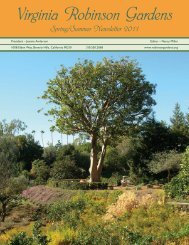Download - Virginia Robinson Gardens
Download - Virginia Robinson Gardens
Download - Virginia Robinson Gardens
Create successful ePaper yourself
Turn your PDF publications into a flip-book with our unique Google optimized e-Paper software.
Educational Lectures and Tours<br />
BOTANICAL ILLUSTRATION WORKSHOPS<br />
“Complete Flower Painting” August 4-6, September 1-3 and October 6-8, 2010<br />
Margaret Best, Instructor<br />
“I can help you with that,” exclaims Margaret, pointing to a muddy patch on the painting.<br />
“It’s not you, it’s the pigment,” she explains. “Without the right pigment, it’s impossible.”<br />
For Margaret Best, a noted Canadian botanical watercolor artist, anything is possible. She is an<br />
expert on color pigments. Her approach to teaching watercolor painting is to first select your paints<br />
carefully, then study the subject and mix the colors you will use in your painting. Once your colors are<br />
established, her students are taught to create remarkable depth and texture by layering one color over<br />
another. While giving individual instruction, Margaret also paints throughout the week, demonstrating<br />
her lessons with skill and humor. Over the course of the summer and fall, students gained substantial<br />
skills and were able to complete an exemplary botanical watercolor.<br />
“Everything I Needed to Know I Learned from Jane Austen.” November 16, 2010<br />
Charles Lynn Batten – Professor of English UCLA<br />
Professor Batten manages to be both an erudite scholar and a witty storyteller. There is<br />
a twinkle in his eye when he poses the question, “Why is Jane Austen’s writing so universally<br />
and timelessly appealing” Professor Batten argues that she is giving us truths about life -<br />
truths about people, human behavior, and self-knowledge. In our own lives we know the<br />
people that populate Austen’s novels. These are characters we recognize as being true.<br />
We face many of the same challenges her characters face. Considering that in her whole<br />
life, Jane Austen never traveled further than one hundred and fifty miles from home, it’s<br />
amazing that she knew so much about life and human nature. Excerpted from S. Taylor Blog<br />
Rise and Sprawl: How Los Angeles Came To Be January 19, 2011<br />
Jim Heimann, Author and Exective Editor of Taschen America<br />
Jim Heimann and Marcella Ruble<br />
Cultural anthropologist and graphic design historian Jim<br />
Heimann is author of numerous books on architecture, pop<br />
culture, and the history of the West Coast, Los Angeles, and<br />
Hollywood. His unrivaled private collection of ephemera has<br />
been featured in museum exhibitions around the world and<br />
dozens of books. Mr. Heimann illustrated his lecture with<br />
many early photos of Los Angeles, The Plaza (Olivera Street)<br />
and Spring Street. He has<br />
researched Los Angeles<br />
history for over 30 years.<br />
The current book includes<br />
over 500 images! We hope<br />
Mr. Heimann will return to<br />
<strong>Robinson</strong> <strong>Gardens</strong> to share<br />
more of his exciting work.<br />
www.robinsongardens.org • 310.276.3302




